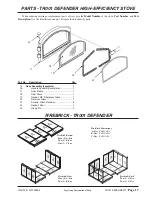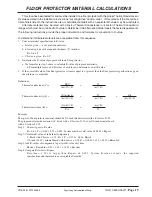
Page 14
/
TR001 DEFENDER™
www.vogelzang.com
VGZ-026 / 20120306.0
SERVICE HINTS continued …
CHIMNEY DRAFT
Draft is a function of the chimney, not the
stove — do not expect the stove to draw. Smoke spillage
into the house or excess buildup of condensation or
creosote in the chimney are warnings that the chimney
is NOT functioning properly. Correct the problem before
using the stove. Following are some possible causes
for improper draft.
1. The connector stovepipe may be pushed into the
chimney too far, stopping the draft.
2. If the chimney is operating too cool, water will con-
dense in the chimney and run back into the stove.
Creosote formation will be rapid and may block
the chimney. Operate the stove at a fire level high
enough to keep the chimney warm preventing this
condensation.
3. If the fire burns well but sometimes creates exces-
sive smoke or burns slowly, it may be caused by
the chimney top being lower than another part of
the house or a nearby tree. The wind blowing over
a house or tree, falls on top of the chimney like
water over a dam, beating down the smoke. The
top of the chimney should be at least three (3) feet
above the roof and be at least two (2) feet higher
than any point of the roof within ten (10) feet.
NOTE: A DRAFT READING OF 0.05 TO 0.06
W.C. (WATER COLUMN) IS SUGGESTED FOR
PROPER BURNING OF THIS STOVE.
GLASS CARE
CAUTION: DO NOT OPERATE WITH CRACKED
OR BROKEN GLASS.
Periodic cleaning of glass will be necessary to
prevent accumulations of ash. Acidic ash buildup can
eventually etch and weaken glass. Creosote accumu-
lations should burn off during hot fires. The following
usage and safety tips should be observed:
1. Inspect the glass regularly for cracks and breaks.
If you detect a crack or break, extinguish the fire
immediately and contact the manufacturer for a
replacement before re-firing the stove.
2. Do not slam the door or otherwise impact the glass.
When closing doors, make sure that logs or other
objects do not protrude to impact the glass.
3. Do not build fires against (or that might fall against)
the glass.
4. Do not clean the glass with materials that may
scratch (or otherwise damage) the glass. Scratches
on the glass can develop into cracks or breaks dur-
ing operation.
5. Never attempt to clean the glass while the unit is hot;
allow to dry thoroughly before reuse. If deposits are
not very heavy, normal glass cleaners are adequate
using a soft, non-abrasive cleaning pad.
6. Never put substances which can ignite explosively
in the unit. Even small explosions in confined areas
can blow out the glass.
GLASS REPLACEMENT
WARNING: REPLACE GLASS ONLY WITH 5MM
HIGH TEMPERATURE CERAMIC GLASS OF
THE PROPER SIZE. DO NOT USE SUBSTITUTE
MATERIALS SUCH AS TEMPERED GLASS
OR DOUBLE THICKNESS WINDOW GLASS!
CONTACT THE STOVE MANUFACTURER FOR
REPLACEMENT GLASS.
Gasket and Glass cleaning products are available
at local retail home centers. Manufacturers of cleaning
products include, A.W. Perkins Co. (www.awperkins.
com) or Rutland Products (www.rutland.com).
After extensive use, the gasket material which
provides glass and door seal may lose it’s resiliency
and will need to be replaced. Inspect glass and door
gaskets periodically to ensure proper seal; if gaskets
become frayed or worn, replace immediately.
Glass Replacement Procedure:
1. Ensure appliance is not in operation and is thor-
oughly cooled.
2. Remove screw and glass clips. (See parts list and
diagram.)
3. Remove glass from door frame.
4. If glass is broken, carefully remove and discard
each broken piece to avoid cuts. Discard window
gasket. Replace window and gasket with original
factory replacement parts.
5. Replace new gasket starting at the bottom of glass
working along edges, being sure to center gasket
channel on glass.
6. Trim to length and butt ends together.
7. Perform replacement procedure in reverse order
after replacing glass and gasket.
8. When replacing glass into door, be sure not to
overtighten screws and clips.
Continued on next page






































